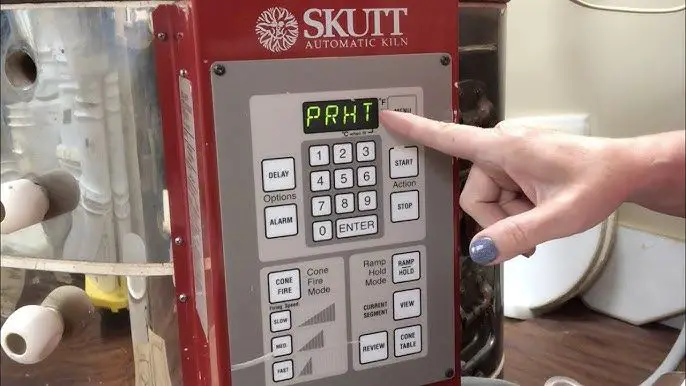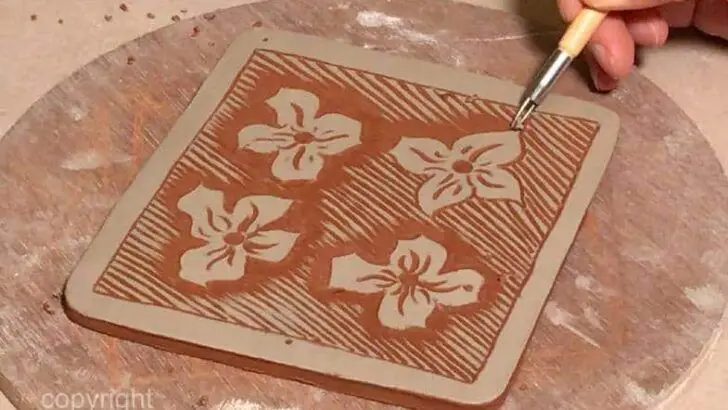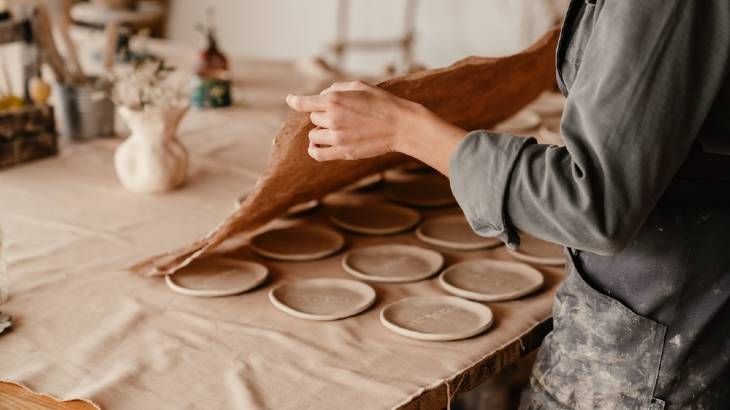How Long Does A Skutt Kiln Last?
Skutt kilns have been a popular choice among ceramic artists and hobbyists since they were first invented in the late 1950s by Bill Skutt, who started the Skutt Ceramic Products company in Portland, Oregon. Skutt pioneered many innovations in kiln technology, including features like sitter kilns, automatic controls, and oval kiln designs (Skutt, n.d.). Today, Skutt offers a range of electric kilns for ceramics, glass fusing, heat treating, and other applications. Many ceramic artists prefer Skutt for the variety of sizes, reliable performance, and ceramic-optimized features like Vent-Sure venting and ceramic element holders. While kiln technology has evolved over the decades, Skutt kilns are still known for their durability, versatility, and ability to maintain even temperatures – hallmarks that have made them a staple in home studios and large-scale ceramic production facilities alike.
Kiln Models and Lifespans
Skutt kilns come in various model lines, each with their own typical lifespan. Some of the most popular models include:
- KM Series – This is Skutt’s basic model line. These kilns tend to last 15-20 years with proper maintenance.
- KS Series – The KS line offers more durability than the basic models. With care, these kilns can last 20-25 years.
- KD Series – Skutt’s heavy-duty model built for longevity. These kilns often last 25-30+ years.
- FireMaster Series – Top-of-the-line kilns made to withstand constant high-fire use. Lifespans of 30+ years are common.
According to users on ceramics forums, well-maintained Skutt kilns used for hobbyist purposes typically last 20-30 years before major repairs are needed. Kilns used in high-volume commercial studios may need rebuilt or replaced more frequently.
The overall lifespan depends largely on the model line. Heavier models with thick insulation and high-quality components tend to far outlast basic hobbyist kilns. With preventative maintenance and careful use, even basic Skutt kilns can provide decades of reliable service.
Kiln Materials and Construction
Skutt kilns are built using high quality materials designed for durability and longevity. The main structural components include:
- Firebrick – Skutt uses top grade firebrick rated for cone 10 temperatures up to 2372°F. The brick is precisely cut and fitted to maximize insulation. Quality firebrick contributes to even heat distribution and minimal heat loss.
- Steel – The outer shell is made with heavy gauge steel up to 3/16″ thick. The steel frame provides structural reinforcement.
- Insulation – High density premium insulation board lines the fire chamber to minimize heat loss.
- Heating Elements – Skutt uses Kanthal A-1 heating elements that are embedded into the firebrick walls. Kanthal contains a high concentration of aluminum and iron for excellent heat resistance.
- Wiring – Skutt kilns use 10 gauge heavy duty wire and water resistant connectors rated for high temperatures.
- Hinges – Custom pivoting hinges allow the lid to be easily lifted while remaining securely attached.
Skutt rigorously tests and inspects all kiln components during manufacturing. This ensures optimal construction with tight tolerances between parts for maximum durability. Skutt kilns are designed to withstand repeated high temperature firings over many years of consistent use (Skutt, 2021).
Maintenance and Care
Proper maintenance and care are critical for maximizing the lifespan of a Skutt kiln. Skutt provides a Kiln Management Manual with detailed instructions for maintenance tasks and schedules. Some key maintenance tips include:
- Inspecting wiring, thermocouples, relays and power connections annually.
- Checking lid and brick fit twice a year.
- Cleaning kiln shelves every 10-20 firings.
- Vacuuming out dust and debris regularly.
- Applying kiln wash on kiln floor/walls every 50 firings.
- Replacing worn out kiln furniture like shelves.
Proper care like avoiding mechanical shocks, operating the kiln per instructions, and monitoring firing cycles closely can also extend the kiln’s lifespan. Neglecting maintenance tasks like replacing old wiring or cleaning air intakes regularly can lead to premature kiln failure. Investing time into proper care and maintenance pays off with years of additional reliable service.
Usage Frequency and Duration
How often and how long a kiln is fired has a significant impact on its lifespan. Frequent firing puts more thermal stress on the kiln and its components. Each firing subjects the kiln to extreme temperature changes, going from room temperature up to over 2000°F and then cooling back down.
According to research by Katz, each firing can reduce the lifespan of electrical components due to the temperature changes causing expansion and contraction [1]. The more often the kiln is fired up, the faster this wear and tear accumulates.

Similarly, longer firing durations increase the thermal stress and physical strain on the kiln. Prolonged exposure to high temperatures can accelerate the breakdown of the insulating firebricks and elements. Manufacturers generally recommend a maximum firing time of 12-24 hours.
Best practice is to fire the kiln only when necessary and avoid excessively long firing sessions. Allowing proper cool down time between firings gives components a chance to stabilize. Following the manufacturer’s guidelines for frequency and duration of firings helps maximize lifespan.
Quality of Electrical Components
The quality and durability of the electrical components have a big impact on the lifespan of a Skutt kiln. Skutt uses high quality Hubble plugs on all kilns over 40 amps, refusing to cut corners by using cheaper components according to The Facts from skutt.com. The heavy duty relays, contactors and durable wires in Skutt kilns are designed to withstand many heating and cooling cycles without degradation. Proper electrical components that do not overheat or degrade over time help ensure a long-lasting kiln.
Each Skutt kiln is fully tested and inspected before leaving the factory according to The Facts on skutt.com. This testing helps identify any potential weaknesses in the electrical system before the kiln is delivered. Overall, the premium electrical components and rigorous testing set Skutt kilns apart, contributing to a longer lifespan compared to models from other manufacturers.
Environmental Conditions
The environment where the kiln is operated can significantly impact its lifespan. Kilns generate a tremendous amount of heat during the firing process. Excessive heat and humidity in the kiln room can accelerate wear and cause damage over time. Proper ventilation is critical to dissipate heat and reduce moisture buildup.
Kilns operated in excessively hot and humid environments may experience warped firebricks, broken elements, and cracked insulation. The binders and coatings on firebrick can weaken or deteriorate. Electrical components like relays and switches fail more quickly in hot, humid conditions. Metals can corrode and warp.
Operating kilns in unventilated rooms or basements often results in rapid deterioration. The heat, fumes, and moisture have nowhere to properly dissipate. Cracking and warping occurs much faster without air circulation. Electrical components overheat. Proper ventilation systems like exhaust fans, vents, HVAC systems help extend kiln lifespan.
Ideally, kilns should be operated in a dedicated, climate-controlled room with adequate ventilation. Avoid placing kilns in unventilated basements or sheds. Check that vents and fans are working properly. Monitor humidity levels in the kiln room. Taking steps to control heat, moisture, and ventilation where the kiln operates can significantly increase its usable lifespan.
Replacement Parts Availability
One factor that can extend the lifespan of a Skutt kiln is the ability to find replacement parts when needed. Skutt kilns use standard components, making many parts widely available.
Elements, relays, contactors and other electrical components can be purchased from sites like Kiln Parts and Clay King. The elements and wiring diagrams are readily accessible for reference when replacing parts.
In addition, many dealers that sell new Skutt kilns also stock replacement parts and can provide guidance on installing them. This makes it relatively easy to maintain and repair a Skutt kiln compared to more proprietary or custom-designed kilns.
The ready availability of parts through third-party retailers and dealers enables Skutt kiln owners to fix problems themselves and extend the usable lifespan of their kilns.
Cost Comparison
When considering the lifespan cost of a kiln, it’s important to analyze both the upfront purchase price as well as the ongoing operating costs over its lifetime. The initial investment in a quality kiln with durable construction and components can pay off in the long run with lower maintenance needs and longer lifespan.
According to one analysis, operating an electric kiln costs approximately 17.6 pence per firing in electricity costs alone (Source). Factoring in the upfront cost of the kiln amortized over expected lifespan firings can provide a fuller cost comparison between different kiln models and materials.
While basic entry-level kilns may have a lower upfront cost, their shorter lifespan of 5-10 years may require earlier replacement. Higher quality kilns with thicker insulation, high grade heating elements, and maximum temperature ratings of 2350°F or greater may carry a higher initial price tag but can last 15-25 years or more under regular use.
Careful consideration of total lifespan costs – both capital expense and ongoing electricity and maintenance – provides the best comparison when choosing a kiln. Investing in durability and longevity allows maximizing value over the many years of firings a well-built kiln can deliver.
Maximizing Kiln Lifespan
To get the longest lifespan from a Skutt kiln, follow these tips:
- Carefully follow the manufacturer’s instructions for installation, operation, and maintenance. Adhering to Skutt’s guidelines can prevent damage and extend the kiln’s lifespan.
- Perform regular maintenance like cleaning the elements and thermocouples. Built up debris can lead to hot spots and element failure over time.
- Avoid thermal shock by preheating the kiln before firing and cooling it slowly after. Drastic temperature changes can crack the brick and shorten the kiln’s life.
- Use the kiln as recommended by Skutt and avoid overfiring. Firing too hot can damage the heating elements and electronics.
- Check wiring connections periodically and replace any degraded power cords or components. Poor electrical connections can cause problems.
- Store the kiln in a covered, climate-controlled area when not in use. Exposure to weather extremes can accelerate wear.
- Keep replacement parts on hand for heating elements, thermocouples, and relays. Promptly replacing worn parts prevents further damage.
With proper care and maintenance, a quality Skutt kiln that’s used appropriately can last for decades and fire thousands of loads.


